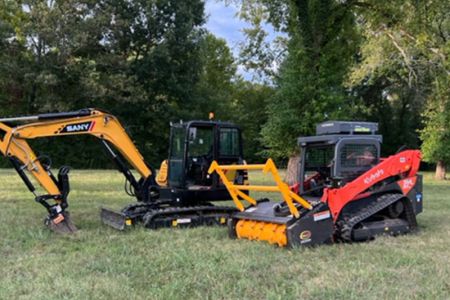
Forestry Mulching vs. Traditional Clearing: What’s Faster & Cheaper in Nashville?

If you’re deciding between forestry mulching and traditional land clearing in Nashville, you’re not alone. Homeowners from Bellevue to Donelson ask us which approach gets results faster and keeps the budget in check. For many Middle Tennessee properties, forestry mulching in Nashville can be the simpler, speedier option because it cuts, grinds, and spreads material in one pass. Still, there are jobs where conventional clearing is the smarter call.
This guide breaks down how each method performs on local soils, slopes, and access points, so you can match the method to your site and plans without guesswork.
What each method really means for a Nashville property
Forestry mulching
Forestry mulching uses a dedicated machine to take down brush and smaller trees, grind them on the spot, and spread the mulch as a protective layer. There’s no separate step for hauling brush piles, and the mulch helps shield our clay-heavy soils from ruts and erosion.
Traditional land clearing
Conventional clearing relies on chainsaws, excavators, and loaders to cut, push, pile, and haul off trees and debris. It is flexible for bigger timber, stump removal, or when you must open up a site for grading, utilities, or a foundation. If your plan calls for a truly bare pad, professional land clearing may still be the best path.
Which is faster?
Speed depends on density, access, and the finish you need. On most overgrown lots with mixed brush, saplings, and a few mid-size trees, forestry mulching is often quicker because material never leaves the ground. The operator moves through the stand, and you watch the area open up in real time.
Traditional clearing can pull ahead when there are many large trees that must be removed root and all. Excavators and saw crews can fell, stump, and pile in parallel, especially if trucks can access the site easily. But once you add cleanup and disposal time, forestry mulching often evens the race back out.
Which is cheaper over the whole project?
Think beyond the first day of work. Ask what happens to debris, soil, and traffic paths after the machines leave.
- Debris handling: Mulching turns debris into ground cover, so you avoid multiple trips for hauling and disposal. Traditional clearing usually requires trucking and dump fees, which adds time and handling.
- Surface restoration: Mulch cushions the soil and reduces ruts. Conventional clearing can require added grading and stabilization to fix disturbed areas, especially on wet clay or slopes.
- Erosion and sediment control: The mulch layer helps hold moisture and reduce runoff channels after a storm. Bare dirt from push-and-pile clearing may need temporary cover or additional visits.
When you account for trucking, cleanup, and site touch-ups, forestry mulching is frequently the value pick for reclaiming space, improving access, and preparing for light use. If you are carving a homesite, trenching for utilities, or cutting a pad where stumps must be gone, traditional clearing plus excavation can be the more direct route.
Local site factors that swing the choice
Nashville’s terrain changes fast from one neighborhood to the next. A hillside in Forest Hills behaves differently than bottomland near the Harpeth. These conditions matter:
- Soils: Heavy red clay stays slick after spring rains. Mulch helps protect the surface until it firms up.
- Access: Tight driveways in Sylvan Park or East Nashville may limit truck traffic, favoring mulching’s single-machine approach.
- Slope: On steeper ground in Brentwood, minimizing skid turns reduces rutting. Mulch can help stabilize disturbed areas.
- Vegetation: Thick privet, vines, and saplings are ideal for mulching. Many large, mature trees or required stump removal lean toward conventional clearing.
- Future use: If you need a clean pad soon for a shed or addition, land clearing for construction gets you closer to final grade.
Environmental and curb appeal benefits
Mulching leaves a neat, wood-chip finish that blends into the landscape. It also helps hold moisture during our hot, dry late summers. For trails, views, or pasture edges, that finish can be a win. Traditional clearing is still the right choice when you need an open canvas for grading or utility work.
Whichever path you choose, ask for a plan to protect healthy trees and topsoil. Clear the invasive stuff and keep the good. A careful approach preserves shade trees in Green Hills or Madison while improving safety and access. Protecting the soil now shortens the path to a stable, attractive yard later.
Seasonal timing in Nashville
Spring storms load the ground with water, which can slow conventional clearing and increase remediation. Early summer often brings better traction. By late summer, soils harden and dust kicks up, which makes mulching attractive for quick visibility and firebreaks. Fall is prime for either method because temperatures cool and vegetation thins. Winter can work, but freeze-thaw cycles may create soft spots that need care.
Scheduling a visit during dry spells and planning machine paths around trees and drains can save time on any method. A good equipment plan reduces rework and keeps neighbors happier.
Hire the Nashville Land Clearing Pros for Your Next Project!